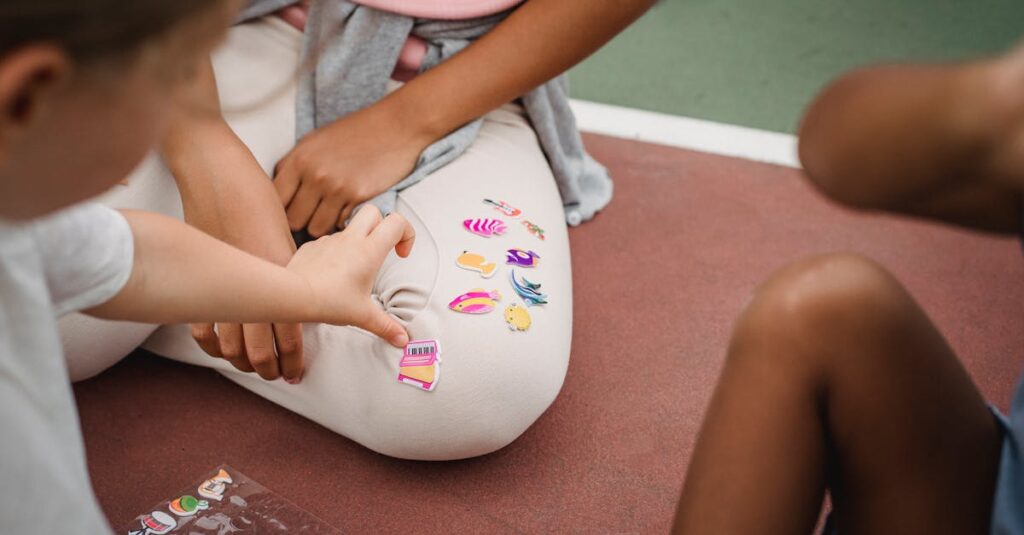Mindful Magic: Coloring for Little Hearts
Picture your toddler with a crayon, deeply immersed in coloring. It’s not just scribbling; it’s a mindful magic moment!
Mindfulness coloring fosters empathy in preschoolers by helping them connect with their emotions. Introduce simple patterns that spark your child’s imagination while teaching them to focus and empathize.
They’ll learn that it’s okay to step outside the lines, just like in life. As they color, discuss feelings that connect to the colors, turning a simple activity into an empathy-boosting adventure.
Trust me, your fridge will never look better with their masterpieces!
Why Empathy Matters in Early Childhood
Empathy isn’t just a buzzword; it’s a crucial life skill, especially in early childhood. Preschoolers face daily challenges of understanding and expressing emotions.
Mindful coloring can aid this learning process by turning colors into emotional expressions. Kids develop empathy by associating colors with feelings, such as:
- Blue for calmness
- Red for excitement
When toddlers see interpretations of their own emotions, they start to comprehend others’ feelings too. As their little minds grow, so does their capacity to understand and care for others — and it all starts with a box of crayons!
Coloring Sessions: A Family Bonding Time
Coloring isn’t just for kids; it’s a wonderful opportunity for family bonding! Sit with your little ones, grab some crayons, and join in on the fun.
Show them that everyone, including adults, needs a creative outlet. Share your own coloring stories, like that memorable time you colored the cat bright green unknowingly! Laugh at the memories and create new ones together.
Benefits of Coloring Together:
- Emotional Conversations: These sessions are perfect opportunities to talk about emotions, share experiences, and teach empathy through your actions.
- Less Intimidating: Shared time makes emotional conversations feel less intimidating for both parents and children.
- Therapeutic Peace: You might even find it therapeutically peaceful too!
So, gather your supplies, unleash your creativity, and strengthen those family ties with some colorful fun!
Navigating Emotions with Colors and Hues
Imagine borrowing your child’s crayons and creating a rainbow of emotions. As kids color, guide them to associate specific colors with different feelings. Green can be for calm moments, while orange might mean they feel playful or energetic.
This approach gives kids the tools to identify their emotions visually. Mindfulness coloring helps them understand that emotions are normal and manageable.
It opens discussions about their day, allows parents to offer support, and encourages kids to express feelings. It’s art but with a twist!
Practical Tips for Parents at Coloring Time
Here are some practical advice tips for you:
- Keep a coloring book within arm’s reach, especially during meltdowns.
- Encourage your little artist by keeping it simple — start with just a few crayons.
- Talk to your child about what they’re drawing and which colors they’re using to decode their feelings.
- Remember, there’s no right or wrong way to color. Use humor when things go off track—like when the sky turns polka-dotted!
- Join them often and make it a judgement-free space, focusing on fun, growth, and empathetic learning.
Join the Mindful Coloring Community
Want to connect with others on a similarly mindful journey? Join online coloring communities for parents and swap stories, tips, and coloring book recommendations. Share your best crayon jokes, like:
Why do pirates avoid the alphabet? Because they hate C’s! Let’s keep the laughter rolling!
Engage in discussions on how coloring enhances empathy in kids, and learn new mindfulness techniques. The support and ideas from like-minded parents help you continue fostering empathy through artistic play.
Reach out, share stories, and build friendships — each coloring page at a time!

